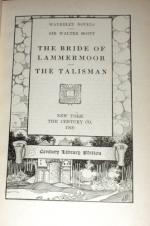Sir, ’tis truth
you’ve told.
We did enjoy great mirth;
but now, ah me!
Our joyful song’s
turn’d to an elegie.
A virtuous lady, not
long since a bride,
Was to a hopeful plant
by marriage tied,
And brought home hither.
We did all rejoice,
Even for her sake.
But presently our voice
Was turn’d to
mourning for that little time
That she’d enjoy:
she waned in her prime,
For Atropus, with her
impartial knife,
Soon cut her thread,
and therewithal her life;
And for the time we
may it well remember,
It being in unfortunate
September; .
Where we must leave
her till the resurrection.
’Tis then the
Saints enjoy their full perfection.
Mr. Symson also poured forth his elegiac strains upon the fate of the widowed bridegroom, on which subject, after a long and querulous effusion, the poet arrives at the sound conclusion, that if Baldoon had walked on foot, which it seems was his general custom, he would have escaped perishing by a fall from horseback. As the work in which it occurs is so scarce as almost to be unique, and as it gives us the most full account of one of the actors in this tragic tale which we have rehearsed, we will, at the risk of being tedious, insert some short specimens of Mr. Symson’s composition. It is entitled:
“A Funeral Elegie, occasioned by the sad and much lamented death of that worthily respected, and very much accomplished gentleman, David Dunbar, younger, of Baldoon, only son and apparent heir to the right worshipful Sir David Dunbar of Baldoon, Knight Baronet. He departed this life on March 28, 1682, having received a bruise by a fall, as he was riding the day preceding betwixt Leith and Holyrood House; and was honourably interred in the Abbey Church of Holyrood House, on April 4, 1682.”
Men might, and very
justly too, conclude
Me guilty of the worst
ingratitude,
Should I be silent,
or should I forbear
At this sad accident
to shed a tear;
A tear! said I? ah!
that’s a petit thing,
A very lean, slight,
slender offering,
Too mean, I’m
sure, for me, wherewith t’attend
The unexpected funeral
of my friend:
A glass of briny tears
charged up to th’ brim.
Would be too few for
me to shed for him.
The poet proceeds to state his intimacy with the deceased, and the constancy of the young man’s attendance on public worship, which was regular, and had such effect upon two or three other that were influenced by his example:
So that my Muse ’gainst
Priscian avers,
He, only he, were
my parishioners;
Yea, and my only hearers.
He then describes the deceased in person and manners, from which it appears that more accomplishments were expected in the composition of a fine gentleman in ancient than modern times:




